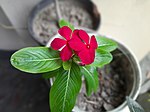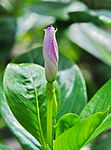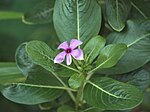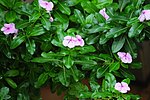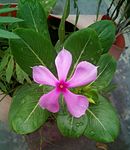bio.wikisort.org - Plant
Catharanthus roseus, commonly known as bright eyes, Cape periwinkle, graveyard plant, Madagascar periwinkle, old maid, pink periwinkle, rose periwinkle,[2] is a species of flowering plant in the family Apocynaceae. It is native and endemic to Madagascar, but grown elsewhere as an ornamental and medicinal plant. It is a source of the drugs vincristine and vinblastine, used to treat cancer.[3] It was formerly included in the genus Vinca as Vinca rosea.
| Catharanthus roseus | |
|---|---|
 | |
| Scientific classification | |
| Kingdom: | Plantae |
| Clade: | Tracheophytes |
| Clade: | Angiosperms |
| Clade: | Eudicots |
| Clade: | Asterids |
| Order: | Gentianales |
| Family: | Apocynaceae |
| Genus: | Catharanthus |
| Species: | C. roseus |
| Binomial name | |
| Catharanthus roseus | |
| Synonyms | |
(See also Synonyms section) | |

It has many vernacular names among which are arivotaombelona or rivotambelona, tonga, tongatse or trongatse, tsimatiririnina, and vonenina.[4]
Synonyms
Two varieties are recognized
- Catharanthus roseus var. roseus
- Synonymy for this variety
- Catharanthus roseus var. angustus (Steenis) Bakh. f.[9]
- Synonymy for this variety
Description
Catharanthus roseus is an evergreen subshrub or herbaceous plant growing 1 m (39 in) tall. The leaves are oval to oblong, 2.5–9 cm (1.0–3.5 in) long and 1–3.5 cm (0.4–1.4 in) wide, glossy green, hairless, with a pale midrib and a short petiole 1–1.8 cm (0.4–0.7 in) long; they are arranged in opposite pairs. The flowers range from white with a yellow or red center to dark pink with a darker red center, with a basal tube 2.5–3 cm (1.0–1.2 in) long and a corolla 2–5 cm (0.8–2.0 in) diameter with five petal-like lobes. The fruit is a pair of follicles 2–4 cm (0.8–1.6 in) long and 3 mm (0.1 in) wide.[12][13][14][15]
Ecology
In the wild, C. roseus is an endangered plant; the main cause of decline is habitat destruction by slash and burn agriculture.[16] It is also, however, widely cultivated and is naturalized in subtropical and tropical areas of the world such as Australia, Bangladesh, India, Malaysia, Pakistan, and the United States.[12] It is so well adapted to growth in Australia that it is listed as a noxious weed in Western Australia and the Australian Capital Territory,[17] and also in parts of eastern Queensland.[18]

Cultivation
As an ornamental plant, it is appreciated for its hardiness in dry and nutritionally deficient conditions, popular in subtropical gardens where temperatures never fall below 5–7 °C (41–45 °F), and as a warm-season bedding plant in temperate gardens. It is noted for its long flowering period, throughout the year in tropical conditions, and from spring to late autumn, in warm temperate climates. Full sun and well-drained soil are preferred. Numerous cultivars have been selected, for variation in flower colour (white, mauve, peach, scarlet, and reddish-orange), and also for tolerance of cooler growing conditions in temperate regions. Notable cultivars include 'Albus' (white flowers), 'Grape Cooler' (rose-pink; cool-tolerant), the Ocellatus Group (various colours), and 'Peppermint Cooler' (white with a red centre; cool-tolerant).[12] In the U.S. it often remains identified as "Vinca" although botanists have shifted its identification and it often can be seen growing along roadsides in the south.
In the United Kingdom it has gained the Royal Horticultural Society’s Award of Garden Merit[19] (confirmed 2017).[20]
Uses
Traditional
The species has long been cultivated for herbal medicine, as it can be traced back to 2600 BC Mesopotamia.[21] In Ayurveda (Indian traditional medicine) the extracts of its roots and shoots, although poisonous, are used against several diseases. In traditional Chinese medicine, extracts from it have been used against numerous diseases, including diabetes, malaria, and Hodgkin's lymphoma.[13] In the 1950s, vinca alkaloids, including vinblastine and vincristine, were isolated from Catharanthus roseus while screening for anti-diabetic drugs.[22] This chance discovery led to increased research into the chemotherapeutic effects of vinblastine and vincristine. Conflict between historical indigenous use, and patent from 2001 on C. roseus-derived drugs by western pharmaceutical companies, without compensation, has led to accusations of biopiracy.[23]
Medicinal
Vinblastine and vincristine, chemotherapy medications used to treat several types of cancers, are found in the plant [24][25][26][27] and are biosynthesised from the coupling of the alkaloids catharanthine and vindoline.[28] The newer semi-synthetic chemotherapeutic agent vinorelbine, used in the treatment of non-small-cell lung cancer,[26][29] can be prepared either from vindoline and catharanthine[26][30] or from the vinca alkaloid leurosine,[31] in both cases via anhydrovinblastine.[30] The insulin-stimulating vincoline has been isolated from the plant.[32][33]


Research
Despite the medical importance and wide use, the desired alkaloids (vinblastine and vincristine) are naturally produced at very low yields. Additionally, it is complex and costly to synthesize the desired products in a lab, resulting in difficulty satisfying the demand and a need for overproduction.[34] Treatment of the plant with phytohormones, such as salicylic acid[35] and methyl jasmonate,[36][37] have been shown to trigger defense mechanisms and overproduce downstream alkaloids. Studies using this technique vary in growth conditions, choice of phytohormone, and location of treatment. Concurrently, there are various efforts to map the biosynthetic pathway producing the alkaloids to find a direct path to overproduction via genetic engineering.[38][39]
C. roseus is used in plant pathology as an experimental host for phytoplasmas.[40] This is because it is easy to infect with a large majority of phytoplasmas, and also often has very distinctive symptoms such as phyllody and significantly reduced leaf size.[41]
Biology
Rosinidin is the pink anthocyanidin pigment found in the flowers of C. roseus.[42] Lochnericine is a major alkaloid in roots.[43]
Toxicity
C. roseus can be extremely toxic if consumed orally by humans, and is cited (under its synonym Vinca rosea) in the Louisiana State Act 159. All parts of the plant are poisonous. On consumption, symptoms consist of mild stomach cramps, cardiac complications, hypotension, systematic paralysis eventually leading to death.[44]
According to French botanist Pierre Boiteau, its poisonous properties are made known along generations of Malagasy people as a poison consumed in ordeal trials, even before the tangena fruit was used. This lent the flower one of its names vonenina, from Malagasy: vony enina meaning "flower of remorse".[45]
Gallery
- Purple Catharanthus roseus
- This one was grown in Bangladesh as a ornamental plant in a flower tub in the balcony of a house
- Off-white Catharanthus roseus
- White Catharanthus roseus
- Red Catharanthus roseus
- White rosy periwinkle
 Catharanthus roseus in Kerala
Catharanthus roseus in Kerala- Purple Catharanthus roseus
- Vinca From a garden at Cox's Bazar, Bangladesh
- Catharanthus roseus in Ishwardi, Bangladesh
- Flower bud in West Bengal, India
- Garden Plant in India
- Common garden plant in India
- Catharanthus roseus in Pakistan
- Grown in Malaysia
- Flower plant raised in India temples
- Fruits and seeds
- Matured fruits of Madagascar Periwinkle
- Immature fruits of Madagascar periwinkle
- Pacifica Burgundy Halo – Madagascar Periwinkle
- Red cultivar of Madagascar Periwinkle
- Potted Plant in New Delhi
- Anther
References
- "Catharanthus roseus". World Checklist of Selected Plant Families (WCSP). Royal Botanic Gardens, Kew. Retrieved 4 August 2019.
- "Catharanthus roseus". Germplasm Resources Information Network (GRIN). Agricultural Research Service (ARS), United States Department of Agriculture (USDA). Retrieved 4 August 2019.
- Moudi, Maryam; Go, Rusea; Yien, Christina Yong Seok; Nazre, Mohd. (2013-11-04). "Vinca Alkaloids". International Journal of Preventive Medicine. 4 (11): 1231–1235. ISSN 2008-7802. PMC 3883245. PMID 24404355.
- de La Beaujardière, Jean-Marie, ed. (2001). "Botanical scientific bames". Malagasy Dictionary and Malagasy Encyclopedia.
{{cite encyclopedia}}: CS1 maint: url-status (link) - Steenis ex Bakhuizen f., Blumea 6: 384. 1950.
- G.Don, Gen. Hist. 4(1): 95. 1837.
- Markgr., Adansonia, ser. 2. 12: 222. 1972.
- Woodson, N. Amer. Fl. 29: 124. 1938.
- Bakh. f.Blumea 6 (2): 384. 1950.
- Markgr. Adansonia, ser. 2. 12: 222. 1972.
- Steenis Trop. Nat. 25: 18. 1936.
- Huxley, A., ed. (1992). New RHS Dictionary of Gardening. Macmillan ISBN 0-333-47494-5.
- Flora of China: Catharanthus roseus
- College of Micronesia: Catharanthus roseus
- Jepson Flora: Catharanthus roseus
- DrugDigest: Catharanthus roseus Archived 2007-09-27 at the Wayback Machine
- "Catharanthus roseus". Orpheus Island Research Station – James Cook University. Retrieved 2 November 2015.[permanent dead link]
- "Factsheet – Catharanthus roseus". Queensland Government. Retrieved 2 November 2015.
- "RHS Plantfinder - Catharanthus roseus". Retrieved 12 January 2018.
- "AGM Plants - Ornamental" (PDF). Royal Horticultural Society. July 2017. p. 16. Retrieved 24 January 2018.
- Nejat, Naghmeh; Valdiani, Alireza; Cahill, David; Tan, Yee-How; Maziah, Mahmood; Abiri, Rambod (2015). "Ornamental Exterior versus Therapeutic Interior of Madagascar Periwinkle ( Catharanthus roseus ): The Two Faces of a Versatile Herb". The Scientific World Journal. 2015: 982412. doi:10.1155/2015/982412. ISSN 2356-6140. PMC 4312627. PMID 25667940.
- Heijden, Robert; Jacobs, Denise; Snoeijer, Wim; Hallard, Didier; Verpoorte, Robert (2004-03-01). "The Catharanthus Alkaloids:Pharmacognosy and Biotechnology". Current Medicinal Chemistry. 11 (5): 607–628. doi:10.2174/0929867043455846. ISSN 0929-8673. PMID 15032608.
- Karasov, Corliss (2001). "Who Reaps the Benefits of Biodiversity?". Environmental Health Perspectives. 109 (12): A582–A587. doi:10.2307/3454734. JSTOR 3454734. PMC 1240518. PMID 11748021.
- Gansäuer, Andreas; Justicia, José; Fan, Chun-An; Worgull, Dennis; Piestert, Frederik (2007). "Reductive C—C bond formation after epoxide opening via electron transfer". In Krische, Michael J. (ed.). Metal Catalyzed Reductive C—C Bond Formation: A Departure from Preformed Organometallic Reagents. Topics in Current Chemistry. Vol. 279. Springer Science & Business Media. pp. 25–52. doi:10.1007/128_2007_130. ISBN 978-3-540-72879-5.
- Cooper, Raymond; Deakin, Jeffrey John (2016). "Africa's gift to the world". Botanical Miracles: Chemistry of Plants That Changed the World. CRC Press. pp. 46–51. ISBN 978-1-4987-0430-4.
- Keglevich, Péter; Hazai, Laszlo; Kalaus, György; Szántay, Csaba (2012). "Modifications on the basic skeletons of vinblastine and vincristine". Molecules. 17 (5): 5893–5914. doi:10.3390/molecules17055893. PMC 6268133. PMID 22609781.
- Raviña, Enrique (2011). "Vinca alkaloids". The evolution of drug discovery: From traditional medicines to modern drugs. John Wiley & Sons. pp. 157–159. ISBN 978-3-527-32669-3.
- Hirata, K.; Miyamoto, K.; Miura, Y. (1994). "Catharanthus roseus L. (Periwinkle): Production of Vindoline and Catharanthine in Multiple Shoot Cultures". In Bajaj, Y. P. S. (ed.). Biotechnology in Agriculture and Forestry 26. Medicinal and Aromatic Plants. Vol. VI. Springer-Verlag. pp. 46–55. ISBN 978-3-540-56391-4.
- Faller, Bryan A.; Pandi, Trailokya N. (2011). "Safety and efficacy of vinorelbine in the treatment of non-small cell lung cancer". Clinical Medicine Insights: Oncology. 5: 131–144. doi:10.4137/CMO.S5074. PMC 3117629. PMID 21695100.
- Ngo, Quoc Anh; Roussi, Fanny; Cormier, Anthony; Thoret, Sylviane; Knossow, Marcel; Guénard, Daniel; Guéritte, Françoise (2009). "Synthesis and biological evaluation of Vinca alkaloids and phomopsin hybrids". Journal of Medicinal Chemistry. 52 (1): 134–142. doi:10.1021/jm801064y. PMID 19072542.
- Hardouin, Christophe; Doris, Eric; Rousseau, Bernard; Mioskowski, Charles (2002). "Concise synthesis of anhydrovinblastine from leurosine". Organic Letters. 4 (7): 1151–1153. doi:10.1021/ol025560c. PMID 11922805.
- Aynilian, GH; Weiss, SG; Cordell, GA; Abraham, DJ; Crane, FA; Farnsworth, NR (1974). "Catharanthus alkaloids. XXIX. Isolation and structure elucidation of vincoline". Journal of Pharmaceutical Sciences. 63 (4): 536–8. doi:10.1002/jps.2600630409. PMID 4828700.
- Yao, XG; Chen, F; Li, P; Quan, L; Chen, J; Yu, L; Ding, H; Li, C; Chen, L; Gao, Z; Wan, P; Hu, L; Jiang, H; Shen, X (2013). "Natural product vindoline stimulates insulin secretion and efficiently ameliorates glucose homeostasis in diabetic murine models". Journal of Ethnopharmacology. 150 (1): 285–97. doi:10.1016/j.jep.2013.08.043. PMID 24012527.
- Pan, Qifang; Wang, Chenyi; Xiong, Zhiwei; Wang, Hang; Fu, Xueqing; Shen, Qian; Peng, Bowen; Ma, Yanan; Sun, Xiaofen; Tang, Kexuan (2019-07-18). "CrERF5, an AP2/ERF Transcription Factor, Positively Regulates the Biosynthesis of Bisindole Alkaloids and Their Precursors in Catharanthus roseus". Frontiers in Plant Science. 10: 931. doi:10.3389/fpls.2019.00931. ISSN 1664-462X. PMC 6657538. PMID 31379908.
- ABABAF, M; OMIDI, H; BAKHSHANDEH, A M (2019). "Germination Indices and Antioxidant Activity Enzyme Responses of Madagascar Periwinkle (Catharanthus Roseus (L.) G. Don) Under Pretreatment by Salicylic Acid". Applied Ecology and Environmental Research. 17 (2): 3989–4005. doi:10.15666/aeer/1702_39894005. ISSN 1589-1623.
- Khataee, Elham; Karimi, Farah; Razavi, Khadijeh (2021). "Different carbon sources and their concentrations change alkaloid production and gene expression in Catharanthus roseus shoots in vitro". Functional Plant Biology. 48 (1): 40–53. doi:10.1071/FP19254. ISSN 1445-4408. PMID 32690131. S2CID 220670971.
- Fraser, Valerie N.; Philmus, Benjamin; Megraw, Molly (September 2020). "Metabolomics analysis reveals both plant variety and choice of hormone treatment modulate vinca alkaloid production in Catharanthus roseus". Plant Direct. 4 (9): e00267. doi:10.1002/pld3.267. ISSN 2475-4455. PMC 7520646. PMID 33005857.
- Singh, Sanjay Kumar; Patra, Barunava; Paul, Priyanka; Liu, Yongliang; Pattanaik, Sitakanta; Yuan, Ling (April 2020). "Revisiting the ORCA gene cluster that regulates terpenoid indole alkaloid biosynthesis in Catharanthus roseus". Plant Science. 293: 110408. doi:10.1016/j.plantsci.2020.110408. ISSN 0168-9452. PMID 32081258. S2CID 211231123.
- Mortensen, Samuel; Weaver, Jessica D.; Sathitloetsakun, Suphinya; Cole, Lauren F.; Rizvi, Noreen F.; Cram, Erin J.; Lee‐Parsons, Carolyn W. T. (December 2019). "The regulation of ZCT1 , a transcriptional repressor of monoterpenoid indole alkaloid biosynthetic genes in Catharanthus roseus". Plant Direct. 3 (12): e00193. doi:10.1002/pld3.193. ISSN 2475-4455. PMC 6937483. PMID 31909362.
- Marcone, C.; Ragozzino, A.; Seemuller, E. (1997). "Dodder transmission of alder yellows phytoplasma to the experimental host Catharanthus roseus (periwinkle)". Forest Pathology. 27 (6): 347–350. doi:10.1111/j.1439-0329.1997.tb01449.x.
- Chang, Chung-Jan (1998). "Pathogenicity of Aster Yellows Phytoplasma and Spiroplasma citri on Periwinkle". Phytopathology. 88 (12): 1347–1350. doi:10.1094/PHYTO.1998.88.12.1347. PMID 18944838.
- Toki, Kenjiro; Saito, Norio; Irie, Yuki; Tatsuzawa, Fumi; Shigihara, Atsushi; Honda, Toshio (2008). "7-O-Methylated anthocyanidin glycosides from Catharanthus roseus". Phytochemistry. 69 (5): 1215–1219. doi:10.1016/j.phytochem.2007.11.005. PMID 18164044.
- "American Society of Plant Biologists". August 2018.
- "Is Periwinkle Plant Poisonous or Toxic?". 9 June 2020.
- Boiteau, Pierre (1999). "vonenina". Dictionnaire des noms malgaches de végétaux (in French). Vol. IV. Editions Alzieu – via Malagasy Dictionary and Malagasy Encyclopedia.
External links
 Media related to Catharanthus roseus at Wikimedia Commons
Media related to Catharanthus roseus at Wikimedia Commons Data related to Catharanthus roseus at Wikispecies
Data related to Catharanthus roseus at Wikispecies
На других языках
- [en] Catharanthus roseus
[es] Catharanthus roseus
Catharanthus roseus es una especie de Catharanthus nativa y endémica de Madagascar. Entre sus sinónimos se incluyen Vinca rosea (el basónimo), Ammocallis rosea, y Lochnera rosea.[1][2][3][ru] Катарантус розовый
Катара́нтус ро́зовый (лат. Catharánthus róseus) — вид вечнозеленых многолетних полукустарников, вид рода Катарантус (Catharanthus) семейства Кутровые (Apocynaceae).Другой контент может иметь иную лицензию. Перед использованием материалов сайта WikiSort.org внимательно изучите правила лицензирования конкретных элементов наполнения сайта.
WikiSort.org - проект по пересортировке и дополнению контента Википедии

